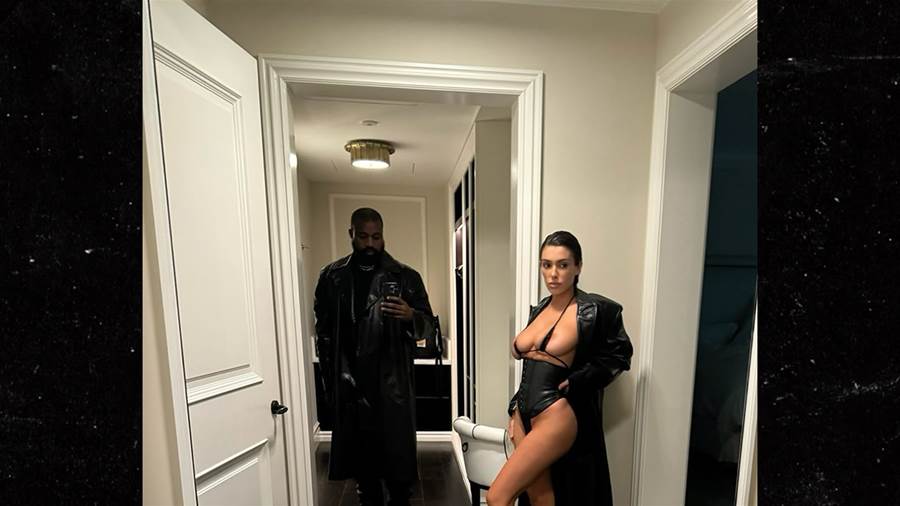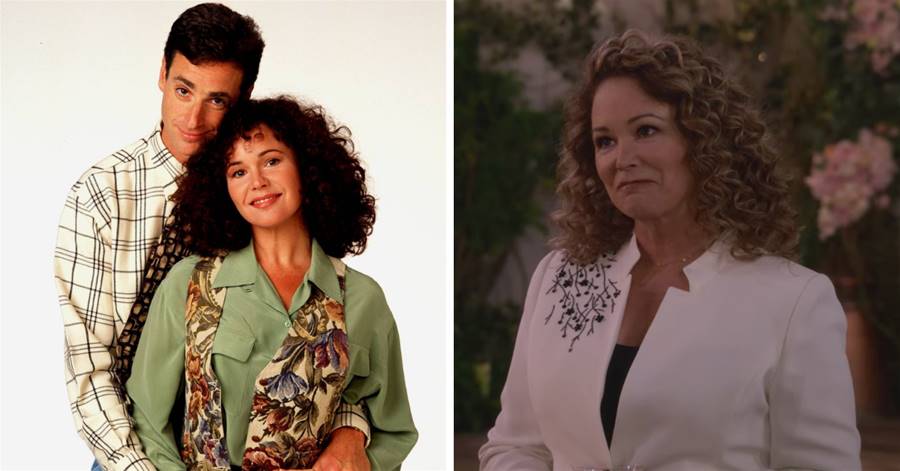
We consume over 2,000 types of fruits in the world, per . Of those, there are thousands more varieties, some rarer than others. Rare can mean exotic fruits that are naturally occurring, like the dangerously tasty monstera deliciosa or . Food scientists are culinary alchemists; imagine knowing how to invent the ideal version of your favorite fruit or vegetable.
Originating from the modest-sized yet ever-innovative island of Japan, Shine Muscat grapes are a new man-made variety causing a serious stir amongst grape lovers. They meet every requirement for being highly sought after and, in only a short period, have developed a large following across Asia.
Korea now competes with Japan as the region's top manufacturer of Shine Muscat grapes. The luxury fruit market has become so popular there that Shine Muscats now comprise 42% of the total land area that Korea designates for grape growing, per . According to , in 2021, Korea's export of Shine Muscats had even grown to exceed Japan's by five times in terms of value.
Beyond being rare, Shine Muscat grapes are fine-tuned for maximum succulence and cost considerably more than your usual oval-shaped niblet. People even give them as gifts on special occasions. Do Shine Muscat grapes have a transformative taste, or are they simply a passing trend? To help clear up all the rumors on the grapevine, join us for a deep dive into Shine Muscats.

Nicknamed "mango grape," Shine Muscats are a man-made variety of muscat that was cultivated in Japan by combining two variations of grapes. According to the , they were introduced to the public in 2003 following a test run that began in 1997. Along with luxurious, these vibrant yellow-green grapes are supersized, seedless, and scarily easy to consume. They are far too pricey for everyday snacking unless you're scuba diving in gold coins. Some bunches cost as much as ¥10,400 (or USD 73) in Japan, and if that doesn't make your jaw drop, trying to fit one of these bulbous beauties into your mouth will.
Shine Muscats are slightly firm with a crisp texture and sweet flavor. Buying them in South Korea can cost you anywhere from 20,000 to 24,000 won per 2 kilograms (or USD 15.26 to 18.31 per 4.4 pounds), per . China has also benefited from offering a cheaper, albeit less tasty, variety. More recently, countries like Brazil and Peru have begun producing regional versions of Shine Muscat grapes, proving that the demand for high-end fruit is alive and well.
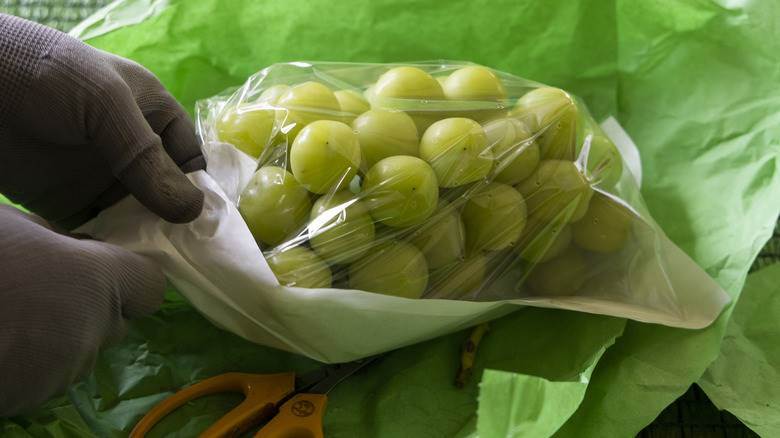
Shine Muscat is a . Scientifically, it's a diploid, which is a cell or nucleus composed of two copies of chromosomes passed down by parent cells. This rarefied fruit was cultivated by combining Akitsu-21, a hybrid of Steuben and Muscat of Alexandria grapes, and Hakunan grapes, which are a cross-breed of European and Japanese cultivars. Historically, farmers had difficulty growing European grapes in Japan's climate. Similarly, the North African Muscat of Alexandria grapes, valued for their appealing aroma, were also too sensitive.
As a workaround, breeders combined it with Steuben grapes and created Akitsu No.
21 in 1973. Shine Muscat was born to the world 24 years later but underwent another 6 years of testing before its official release. Today, they are grown in vineyards that offer a balance of sun and shade and are sheltered against insects by paper bags. August through September is the peak harvest time for grapes grown in the open fields. To achieve the ideal size, growers employ a process called thinning, which involves removing a third of every 100 grapes to allow for space.
Distinct varieties of Shine Muscat grapes are grown in Japan, South Korea, China, and other countries. Despite the varying types, Japan is the largest and original producer, even going so far as to sentence seed thieves to 10 years in prison.
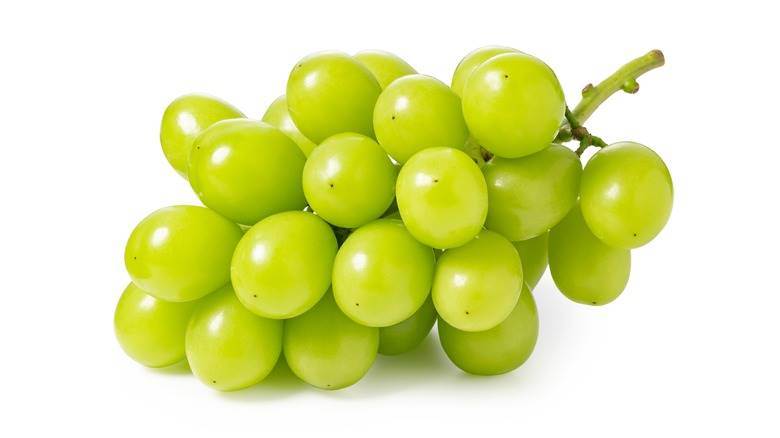
The Shine Muscat industries across Asia offer similar yet distinct varieties of grapes. According to the , the grapes produced by Japan and Korea offer a similar sweetness. Japanese muscats are superior in texture and crispness, with Korea's following in a close second. Where Korea does have an edge is in the aroma; it carries a robust floral, sweet, and fruity pleasantness. In December 2022, Shine Muscats ranked as Lotte Mart's fourth highest-selling fruit (via
); Lotte Mart is a popular South Korean hypermarket retailer. Orders from Gimcheon City Agricultural Center, Korea's top Shine Muscat producer, had tripled compared to three years prior. Another edge helping Korea dethrone Japan as the premiere muscat purveyor is exporting them to foreign consumers.
While Japan and Korea duke it out over who holds the top spot, China seems content as the third runner-up. In terms of taste, Chinese muscats have less sweetness and sourness, along with a tamer aroma. They also differ in skin thickness, whereas the others have thin, edible skin that is characteristic of Shine Muscats.
Prices can also vary from country to country. Rumor has it that the Korean and Chinese versions are actually Shine copycats that were smuggled out of Japan, per . Funnily enough, Brazil now grows similar gourmet grapes called "Pilarmoscato." Seems that the grape's out of the bag.

When it comes to taste, this prized fruit lives up to the hype. Its aroma is distinctively muscat: floral and subtly sweet. You can consume it whole because it's seedless and has thin, neutral-flavored skin like common grape varieties.
Biting into one releases a burst of saccharine bliss, finishing with a grape bubblegum aftertaste. Consistency-wise, it's like a firm jelly and has just the right amount of sweetness without the tart notes that Western green grapes do.
The taste varies only slightly between the Japanese, South Korean, and Chinese versions, with the first two being quite similar. China's Shine Muscats have thicker skin without floral notes, and the flavor can range from overly sweet to sour and astringent. One thing each share is juiciness. Brand type plays a role in flavor, too. Some are more fragrant, while others are candy-like or have sour skin.
Either way, you'll probably find yourself scarfing down more of these tiny delicacies than you expect.
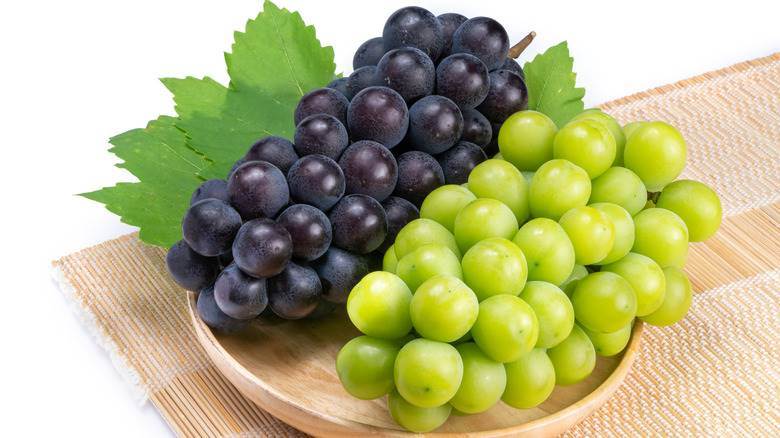
The Land of the Rising Sun is no stranger to luxury fruits and Shine Muscat grapes aren't the only high-priced option on the block. Kyoho is another famously pricey . According to , it's a hybrid that was developed in 1937 by Yasushi Oinoue and is crossbred with Centennial, a white seedless variety from California, and Japan's own Ishiharawase red grapes.
Released to the Japanese public in 1957, these opulent treats are usually sold at luxury fruit retailers, high-end grocery chains, and local markets.
Dark purple-colored Kyoho grapes are large-sized, like Shine Muscats, with dark pink flesh. A single berry could easily be mistaken for a plum. They taste similar to concord grapes and can be found throughout Asia and around the world. While both are common gifts for special occasions, Kyoho, in particular, symbolizes friendship. Shine Muscats are harder to find because they are newer to the market, but these purple-hued fruits are more than comparable in quality.
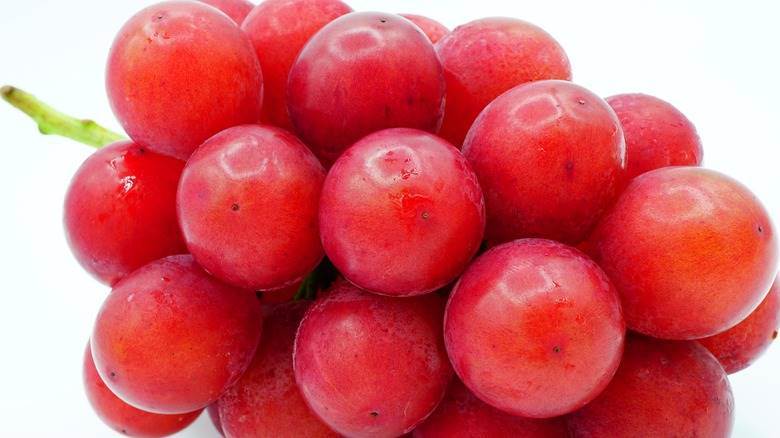
While we're on the topic of expensive fruits, Japan is home to yet another list-topper called Ruby Roman grapes. Held to the strictest of standards, according to , they are a variety exclusively grown in Japan's Ishikawa Prefecture. A vivid red, Ruby Roman grapes are usually around 30 mm, or ½ inch, in diameter. One way to think of them is ticking flavor bombs. Beneath their crimson skin lies gold and green flesh brimming with juiciness.
It somewhat resembles a kiwi, per .
In Ishikawa, the grapes are kept in highly controlled environments and monitored around the clock. From the lighting to the temperature, everything is done with specificity. What's more, only select farms are granted permission to grow them. The guidelines cover an individual grape's weight, sugar content, and color. Grapes that don't meet the requirements aren't sold; it's as simple as that. Like the Shine Muscat variety, these rare beauties fetch a pretty penny and are considered A single bunch has been known to sell at around a whopping $10,000 per .
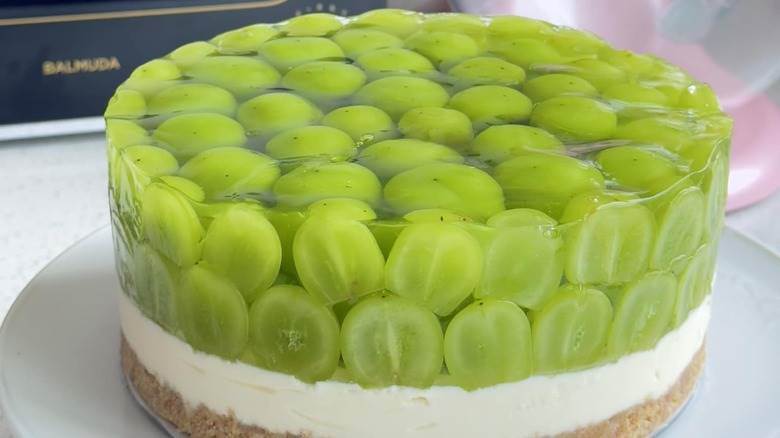
The grape bubblegum taste of Shine Muscats pairs nicely with all sorts of desserts. From fruity tarts and delectable smoothies to palate-pleasing parfait and simple sorbets, Shine Muscats will give your everyday dessert a luxury upgrade. An easy recipe that you can elevate with muscat magic is no-bake cheesecake. Creamy and crumbly, it incorporates not only the fruit itself but also muscat wine jelly. All you have to do is mix the ingredients and refrigerate.
Muscat wine jelly can be enjoyed as a solo treat as well, on a charcuterie board or cheese tray.
Gorgeously gelatinous, the jelly is also used to make Shine Muscat parfait, a no-frills recipe that only requires baking a simple chiffon cake and topping it with ingredients. A fork-full will surely send your stomach over the moon. For a refreshing beverage, blend the grapes in a smoothie. It takes just 10 minutes and the only additional ingredients required are milk, yogurt, honey, and water. Like common grape varieties, you can freeze Shine Muscats for a chilly snack, too. There are no limits to enjoying this special fruit, depending, of course, on how deep your pockets are.

With such a prized grape, using it to make wine and concoct cocktails is only right. Several brands offer Shine Muscat wine, many of which are uniquely Asian. In South Korea, you can find grape-infused rice wine that also doubles as a cocktail. For a truly luxury level-up, a Japanese brand makes a wine that combines both Shine Muscat and Kyoho grapes. There's also a Chinese brand that sells a sweet wine that's surprisingly affordable considering the main ingredient.
If cocktails are more your kick, put a refreshing spin on a Whiskey Collins with elderflower liqueur, fresh lemon, tonic water, and Shine Muscat. It's the perfect nightcap. The beverage manager of Hong Kong's Mandarin Oriental Hotel, Devender Sehgal, masterminded a selection of Shine Muscat cocktails with the help of his team. Their Muscat Gin Fizz puts a new spin on an old classic. Another, called the Seductive Muscat, is a variation on a Bee's Knees-style cocktail that includes Umeshu, which is a Japanese liqueur made from unripened plums. The team's third creation is the Nagano, a gin-sour cocktail infused with spicy and floral sweet potato Shochu.
These are but a few of the Shine Muscat bevvies to indulge in. Beyond wine and cocktails, you can even find Shine Muscat soda in South Korea.
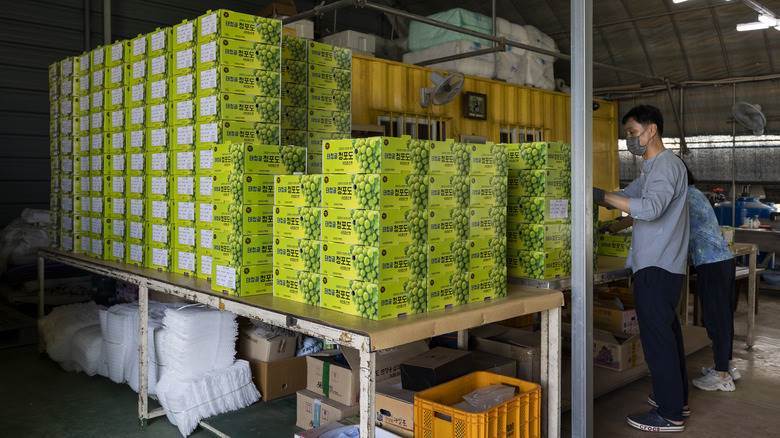
Shine Muscat grapes are primarily available in Asia, yet can also be found at stores in London, America, and Canada. In their hometown, Japanese locals spend a pretty penny on them at luxury fruit shops or grocery stores. A single bunch can cost you between ¥7,000 to ¥10,400 (or USD 49 to 73) per pound.
Thankfully, grapes come in aesthetically pleasing packaging worthy of gift-giving. If fortune favors you, you may find cheaper ones for $25 to $40 per bunch, but those are rare. For those outside of the country who want to experience the authentic Japanese variety, some websites ship internationally.
Although Japan is still known for producing the best quality grapes, Korean muscats are arguably just as awesome. In its bustling muscat industry, they can cost as low as ₩9,990 (or USD 8) per pound, which is still pretty expensive. On the higher end, a brand named Evergood sells a bunch for $50.
Find them at supermarkets and lux fruit purveyors. Fun fact: Most Shine Muscats sold in Western countries are exported from Korea. There is one caveat: The further you travel outside of Asia, the more questionable the quality. A Canadian brand named Eloasis sells a bag for CAD 20.77 (or USD 15.50) per pound.
Another thing to watch out for is fake Shine Muscats. As with any highly sought-after good, some retailers will mislead you with lookalikes. Just remember that whether you buy them locally or from abroad, Shine Muscat grapes aren't cheap.
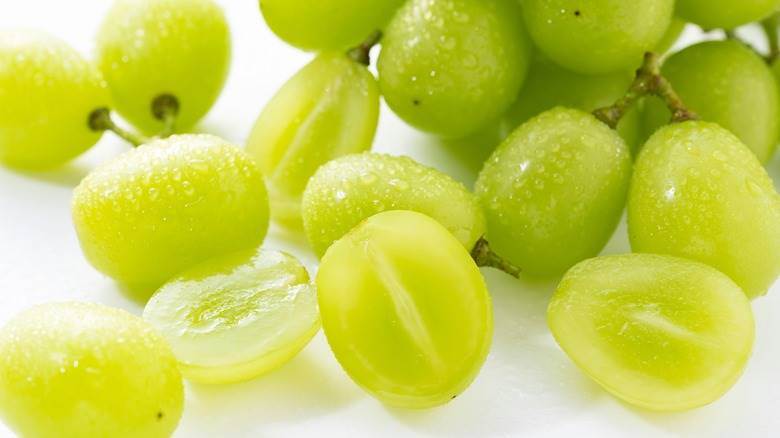
Aside from being pricey and pretty, Shine Muscat grapes are an excellent source of nutrition. They are loaded with immunity-boosting vitamin C, vitamin K for healing wounds and bone health, and vitamin B6, which provides a wide range of benefits, per . Shine Muscats are also potassium-rich, which according to , is your body's third most abundant mineral. It helps manage processes like fluid balance, muscle contractions, and nerve signals.
The impressive list of benefits doesn't stop there either; Shine Muscats are particularly rich in iron, an essential mineral that assists red blood cells with moving oxygen throughout your body (via
). They are also filled with magnesium, a highly important macro mineral for producing energy. Rounding out its health-supporting checklist is polyphenol, a plant compound found in foods that boosts digestion and protects against heart disease, certain cancers, and type 2 diabetes, per .
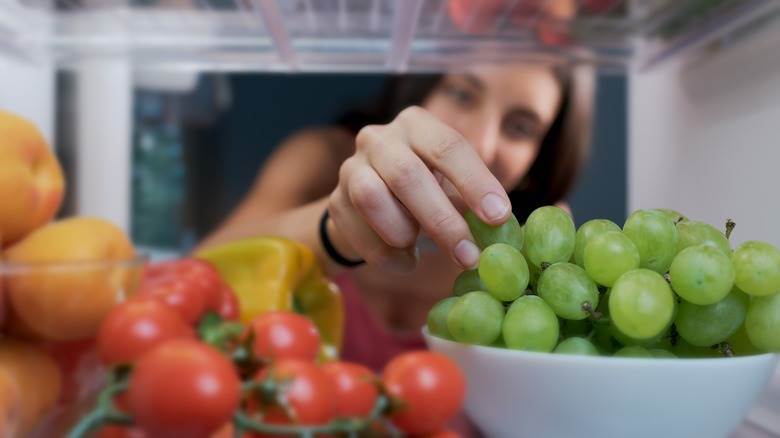
When you break the bank on luxury food items, the absolute worst thing you can do is to store them improperly. With a little consideration and the right container, it's easy to avoid
, and fortunately, you don't need expensive gold-lined tupperware to safekeep this special fruit. Grapes last longest in high-humidity locations with good air circulation. Because grapes benefit from ventilation, we recommend removing the fruit from its plastic packaging. It can actually be stored in your fridge's crisper drawer without a container.
According to , 50 degrees F is the most suitable temperature for retaining the floral aroma — lower temperatures will weaken the scent. Refrigerated grapes can last up to 3 weeks while frozen can be stored for a full year. Also, you should delay rinsing your grapes off until you're ready to eat them because dampness can attract bacteria growth.
After chilling, let them sit for at least 30 minutes before digging in.






